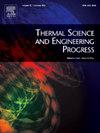Experimental and numerical study of suppression synergistic mechanism of Novec1230 and Trans-1233zd
IF 5.1
3区 工程技术
Q2 ENERGY & FUELS
引用次数: 0
Abstract
Novec 1230 is considered to be the most promising halon alternative recently because of the low Global Warming Potential (GWP) and minimum extinguishing concentration (MEC). However, the fire suppression performance is believed to be strengthened with the mixed chemical gas agents. With an aim to prob the flame suppression effect of mixed fluorinated chemical gas, this study combined Novec 1230 and trans-1233zd, carried out a series of experiments, studied MEC, and proposed the potential synergistic mechanism between the two gases. The MEC is tested by using a bench scale of cup burner platform. When the volume fraction of trans-1233zd is 80 %, 60 %, 50 %, 40 % and 20 %, the MEC of the mixed chemical gas is 7.0 %, 6.5 %, 6.2 %, 5.9 % and 5.7 %. In addition, the synergistic effect model was calculated theoretically and set up on the basis of experimental results. The synergistic factor F has a minimum value of 0.94 when the volume fraction of trans-1233zd is 20%. The synergistic effect is found to be obvious because the experimental value is much lower than the theoretical value. Then, the study analyzed the synergistic mechanism between Novec 1230 and trans-1233zd at the molecular level using the Gaussian 16 code. The results showed that the reaction between the pyrolysis products of Novec 1230 and trans-1233zd produced more ·CF3, ·C2F5 and ·C3F7 groups, which helps to consume the free radicals in the fire scene and achieve the blocking of the chain reaction. This study provides valuable guidance for the application of Novec 1230 and new fluorine-containing gas mixture in fire extinguishing, which will be helpful for the research and development of new chemical gas fire extinguishing agents in the future.
Novec1230与Trans-1233zd协同抑制机理的实验与数值研究
Novec 1230由于具有较低的全球变暖潜能值(GWP)和最低的灭火浓度(MEC),被认为是最近最有前途的哈龙替代品。然而,混合化学气体剂可以增强其灭火性能。为了探讨混合氟化化学气体的抑火效果,本研究将Novec 1230与trans-1233zd结合,进行了一系列实验,研究了MEC,并提出了两种气体之间可能的协同作用机制。利用杯式燃烧器平台的实验规模对MEC进行了测试。当trans-1233zd的体积分数分别为80%、60%、50%、40%和20%时,混合化学气的MEC分别为7.0%、6.5%、6.2%、5.9%和5.7%。此外,对协同效应模型进行了理论计算,并在实验结果的基础上建立了模型。当trans-1233zd体积分数为20%时,协同因子F最小值为0.94。由于实验值远低于理论值,因此发现协同效应明显。然后,利用高斯16码分析了Novec 1230与trans-1233zd在分子水平上的协同作用机制。结果表明,Novec 1230与trans-1233zd的热解产物反应产生更多的·CF3、·C2F5和·C3F7基团,有助于消耗火灾现场的自由基,实现连锁反应的阻断。本研究为Novec 1230及新型含氟气体混合物在灭火中的应用提供了有价值的指导,对今后新型化学气体灭火剂的研究和开发有一定的帮助。
本文章由计算机程序翻译,如有差异,请以英文原文为准。
求助全文
约1分钟内获得全文
求助全文
来源期刊

Thermal Science and Engineering Progress
Chemical Engineering-Fluid Flow and Transfer Processes
CiteScore
7.20
自引率
10.40%
发文量
327
审稿时长
41 days
期刊介绍:
Thermal Science and Engineering Progress (TSEP) publishes original, high-quality research articles that span activities ranging from fundamental scientific research and discussion of the more controversial thermodynamic theories, to developments in thermal engineering that are in many instances examples of the way scientists and engineers are addressing the challenges facing a growing population – smart cities and global warming – maximising thermodynamic efficiencies and minimising all heat losses. It is intended that these will be of current relevance and interest to industry, academia and other practitioners. It is evident that many specialised journals in thermal and, to some extent, in fluid disciplines tend to focus on topics that can be classified as fundamental in nature, or are ‘applied’ and near-market. Thermal Science and Engineering Progress will bridge the gap between these two areas, allowing authors to make an easy choice, should they or a journal editor feel that their papers are ‘out of scope’ when considering other journals. The range of topics covered by Thermal Science and Engineering Progress addresses the rapid rate of development being made in thermal transfer processes as they affect traditional fields, and important growth in the topical research areas of aerospace, thermal biological and medical systems, electronics and nano-technologies, renewable energy systems, food production (including agriculture), and the need to minimise man-made thermal impacts on climate change. Review articles on appropriate topics for TSEP are encouraged, although until TSEP is fully established, these will be limited in number. Before submitting such articles, please contact one of the Editors, or a member of the Editorial Advisory Board with an outline of your proposal and your expertise in the area of your review.
 求助内容:
求助内容: 应助结果提醒方式:
应助结果提醒方式:


